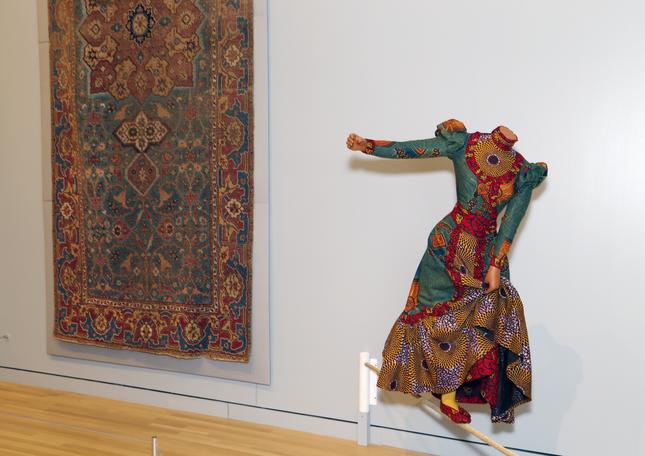Walking through the Textile Museum’s new exhibition, “Unraveling Identity,” I became aware of just how meaningful a role fashion plays in my life.
I am not a fashionable sort of person. “Nice outfit” is never a compliment I have received. Striving at best to blend into the background of a well-dressed workplace, my wardrobe takes on a monochromatic economy of blue-gray with occasional fits of red. The only goal here is for the plainness of my outfits to avert any deeper third-party appraisal of how well the clothes actually fit (not very).
But that doesn’t mean I don’t stand in front of my closet every morning in utter defeat, staring hopelessly at my modest assembly of overworked shirts and pants for a moment of fashion inspiration that never strikes. So, I put on the shirt I presume was worn least recently, smooth out my rumpled chinos with a few brisk swipes, walk out the door and try not to think about the whole sad ordeal.
Even as I write this, I struggle to focus on the subject of clothing.
From a vague and squinty distance, I can recognize the general overwhelming significance of cloth to human history. Along with things like language, architecture and religion, it exists in the rarefied pantheon of the earliest and most essential and lasting inventions that defined humanity. Across oceans, the disparate tribes of early man each devised the same solution to a problem no animal had ever considered: how to cover their bodies.
For millennia, textiles and clothing have functioned in the world as products and symbols of social status, industry, currency, religion and even – in some notable 20th-century cases – human rights.
When Nelson Mandela was imprisoned on Robben Island in South Africa in the 1960s, one of the first causes for which he fought (and won) was the inmates’ right to wear pants instead of shorts; shorts were for boys and he and his comrades were civilized men.
The simple act of making yarn on a spinning wheel was elevated to almost a religion by Gandhi in the 1920s. A symbol of resistance against British colonial rule, Gandhi spun for an hour a day as a call for Indians to achieve self-sufficiency, refusing British cotton goods and readopting the use of local handicrafts.
All of these conversations surround “Unraveling Identity,” a stunning exhibition on view through August 9 in the Textile Museum’s beautiful new space at George Washington University. Taking up all three floors of the museum, it feels like a well-earned retrospective of the museum’s historic collection of textiles, spanning centuries and almost every continent.
Loosely arranged by categorical themes, the show explores the international history of textiles as sources and signifiers of political, cosmopolitan, religious and spiritual identity.
What we find are far more than garments: Incan crowns made of radiant yellow bird feathers, the shockingly tiny silk slippers worn by Chinese women after excruciating foot-binding rituals, Iranian silk and metal ground panels from the 17th century which once functioned as international trade currency in Southeast Asia (they required over a year to weave and were perhaps used as throne covers in the Siamese courts).
On the second floor, a profound and powerful display of grand hangings and rugs from the 16th-century Ottoman Empire confronts visitors.
We are also greeted with more modern pieces that turn out to be no less exquisite or peculiar: Audrey Hepburn’s famous black feather dress from “Breakfast at Tiffany’s,” the chess-like Royal costumes from the 1953 coronation of Queen Elizabeth II (like something out of Lewis Carroll, both hallowed and alien), even a hand-knitted Batman suit made of yarn by contemporary artist Mark Newport, which hangs hysterically limp on a closet hanger and casts a skeptical eye toward our own culture’s bizarre fetishistic superhero worship.
And here I sit, in a pair of khaki shorts and a moth-eaten tank top that used to belong to my mother. What does this mean? Would it make any difference if I were writing this column wearing a tailored suit and an ascot? Is this my small way, as someone otherwise devoted to aesthetic principles, to cast my arty pretensions aside and play the part of the bedraggled creative genius?
Prior to now, I would have insisted that the very idea was a load of rubbish; I simply don’t give a damn and I’m comfortable. But after seeing this exhibition, I am forced to concede that this is probably exactly what I am doing. Like it or not, what we wear is a choice, a reflection of who we are. It is deeply rooted through a lifetime of looking through old family albums at the black wool suits our grandparents wore, and watching the silly debates over Hillary Clinton’s pantsuits and enduring the endless Style Weekly barrage in checkout lines and the wonderfully irreverent fashion policing of Joan Rivers on Hollywood’s red carpet.
It is who we are, how we define ourselves for friends, family and strangers alike. It is how we compare ourselves to one another, to our past and to the emerging generations of defiant, tacky teenyboppers. It is how we step out into the world and say, “This is me.” It is indeed how we unravel our identity.


